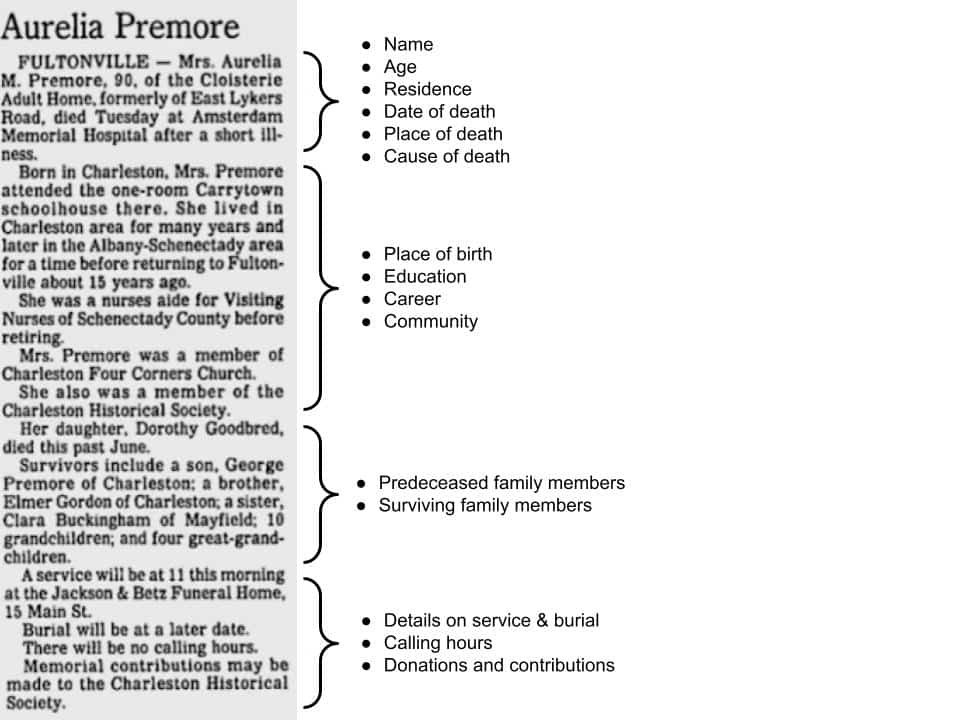How to Write an Obituary
- By Daniella


As the family historian, or simply as a mortal human, you may find yourself presented with the difficult task of writing an obituary for a family member who has recently passed. If you are a genealogist, you know how valuable obituaries can be. They often contain far more detail than any other death record, sometimes providing information about the deceased person’s life that you would never learn from any other source. You can search through MyHeritage’s 102 newspaper collections to discover some fascinating obituaries from the U.S., Canada, and around the world.
But how do you summarize an entire life in a few paragraphs? How do you write something that will honor the memory of your loved one and help others honor that memory?
First things first:
What is an obituary?
The word “obituary” comes from the Latin “obitus,” meaning “death.” An obituary is a notice of death, traditionally printed in a local newspaper, that describes the life of the deceased. When a person who was famous or well-known dies, newspapers will typically print an obituary summarizing that person’s life and accomplishments. In other cases, the family may choose to write something and have it published in a local newspaper or on a dedicated website.
What to include in an obituary
Obituaries don’t have to be especially long or detailed. In fact, if it makes it easier for you, you can simply follow a template or formula (we’ll demonstrate below). This may be best if you are paying to have the obituary printed in the local paper and have limited space.
However, the more detail you add, the more value it will bring — both to the people who knew the deceased and to those who didn’t have a chance to. Plus, even if you’re going to be publishing an obituary in the paper, it may be a good idea to write a longer, more detailed one to share online, whether it’s via social media, a blog, a funeral home website, or just as an email to family and friends.
What does an obituary look like?
Below is an example of an obituary from the MyHeritage newspaper collections. This obituary for Aurelia Premore appeared in The Daily Gazette, Schenectady County, New York, on April 6, 1995:

Obituary from The Daily Gazette, Schenectady County, NY, April 6, 1995. Courtesy of the MyHeritage newspaper collections
This is an excellent example of a formulaic, simple obituary. It begins with the name and age of the deceased at the time of death, and goes on to note the date, place, and cause of death. The next few paragraphs offer some background information on the life of the deceased, including her place of birth and her education, and a little about her career and her activities in the community. Next, the obituary mentions the family members of hers who predeceased her, and then the family members who are still alive. Lastly, the obituary offers practical information on the service, burial, and calling hours, and then mentions a nonprofit that was important to the deceased that friends and acquaintances are invited to contribute to in her memory.
How do you write an obituary?
The example above should give you an excellent structure to work with if you want to keep it simple and brief.
If you’d like to write something more detailed, a good way to get yourself in the right mindset is to imagine you are describing your loved one to a future descendant of theirs. What do you think that future descendant would like to know about this person? What would the deceased want that descendant to know?
It may be easiest to start by writing down the basic, dry facts:
- Where and when were they born?
- Who were their parents and siblings?
- Where did they receive their education?
- What was their profession?
- Did they marry? If so, whom, and when and how did the couple meet?
- Did they have children? When were they born?
- When did they die, and what was the cause of death?
- Which family members died before them, and which are still living?
Then, see if you can add richer details:
- What stories do you know from their childhood? What was it like for them growing up?
- What were their most important accomplishments in their professional and personal life?
- What challenges did they face and overcome during their lifetime?
- What are some memories you have of them, or stories about them that got told and retold in the family?
Once you have all these details, you can organize them chronologically, starting with their birth and ending with their death.
Many find the process of writing an obituary to be cathartic, and a good opportunity to spend time thinking about your experiences with your loved one. It can be difficult emotionally, but certainly rewarding — not only for you, and not only for the friends and family who will read it now, but also for the future genealogist seeking to learn more about an ancestor they never got to meet.
If you are seeking to learn more about an ancestor you never got to meet, search the MyHeritage historical record collections to discover obituaries and many other types of records that can shed light on your family’s past.









